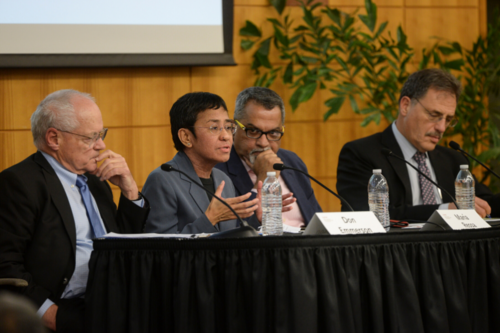The perception of China’s handling of the coronavirus pandemic has been a significant challenge for the Chinese Communist Party (CCP) over the past two months. The CCP has been attempting to control the narrative and deflect blame since the start of the outbreak, both domestically and abroad. It has done this by drawing on its substantial state- and CCP-owned media apparatus.
Chinese state media produces and disseminates daily English-language content to English-speaking audiences via Facebook and Twitter (platforms that are technically banned in China). Chinese state media’s English-language Facebook pages post very frequently, and have extremely large audiences. CGTN has over 96 million Page likes; CNN in contrast has only 32 million. These media properties run ads regularly to grow their audiences, which suggests that China invests in these pages as a tool for communicating its message to the English-speaking world. Facebook’s Ads Library shows specific regional ad targeting in India (Punjab State), Nepal, Bangladesh (Dhaka) and the Philippines (Manila), suggesting that English is used to communicate state views to a broad global audience.
To look at how coronavirus narratives targeting English-speaking audiences have played out on Chinese state media, and how they evolved as the outbreak has moved through various phases, we analyzed a data set of Facebook posts containing the keyword “coronavirus” from two distinct sets of media properties: 1) a collection of English-language Chinese (state) media outlets, and 2) a collection of U.S. media outlets*. This “coronavirus” dataset contained 6,870 posts from Chinese media between December 31, 2019 and March 16, 2020, and 13,522 posts from U.S. media outlets over the same period. While Chinese media has increased its coronavirus coverage in January and stayed at a consistent level since then, U.S. media Facebook posts on the coronavirus stayed at low levels until late February, then soared (see histograms below).

Chinese outlets (left) increase the number of Facebook posts on coronavirus in late January. U.S. media coverage was light until a sudden increase of posts since late February.
China’s media spin: rapid recovery
Chinese and U.S. media articles display different levels of both alarmism and optimism in their coverage of the global pandemic. Chinese outlets included many articles with a focus on positive stories such as the number of recovered patients and examples of successful treatments, while U.S. media reported on new cases of infections and trends in death. For example, Chinese state media reported on a coronavirus patient who gave birth to a healthy baby not infected with coronavirus, whereas the U.S. media told the story of a different newborn in Wuhan who had become the youngest coronavirus patient. CNN credited the story’s source as Chinese state media CCTV, yet no English-language Chinese state media posted this story on their Facebook pages.

Chinese state outlet China Daily (left) reports on a baby born to a coronavirus patient with no infection, whereas CNN (right) reports on a newborn baby becoming the youngest person diagnosed with coronavirus
We searched our dataset for the word “patient” and analyzed words commonly used before or after “patient” in Facebook posts made by Chinese state media and U.S. mainstream media. From December 31, 2019 to March 16, 2020, the term “infected” was commonly used in connection with “patient” in both the American and Chinese media (see word clouds below). However, beyond that common term, there are significant divergences, such as the U.S. media reporting on patients as “sick” or “affected”, and the Chinese media frequently mentioning treatment- and recovery-related terms such as “treating”, “recovered”, “discharged” and “cured”.

Words frequently used in connection with the word “patient” by Chinese media (left) and U.S. media (right); Exclude “patient” and the term “coronavirus” for better visibility of other terms. Chinese media use several recovery- and treatment-related terms.
The English-language Chinese state media has also aggressively reported positive stories about the make-shift hospitals built for China’s immediate emergency response to the coronavirus outbreak. Leishenshan and Huoshenshan hospitals were built in just a few days in late January to early February. Chinese state media disseminated stories about how the international community was “impressed” with China’s rapid building capacity, calling the quick progress of the construction a “miracle.” U.S. media also reported on the rapid building of the hospitals but presented them in a less positive light, saying they were a response to overwhelmed medical facilities or that the temporary structures should not be characterized as hospitals.

Chinese state outlet CGTN (left) calls the hospital a “construction miracle”, whereas NPR (right) reports on the building, but qualifies it that the term “hospital” for the building ”may not be exactly on point”
The Li Wenliang Case
A significant story that played out as the coronavirus outbreak unfolded was that of late whistleblower doctor Li Wenliang, who was one of the first to report the existence of the novel disease warning fellow medics in a chat group on December 30, 2019. His warnings were shared publicly and reached a wide audience online. On January 3, 2020 police detained and forced him to sign a letter stating he had made “false comments.” In a late January post on Chinese social media Weibo, Li reported from his hospital bed that he was in an intensive care unit with breathing difficulty. Li Wenliang died of COVID-19 on February 7, 2020 at age 34. The significant public anger that erupted over his death created a very dangerous moment for the Chinese regime, and required Chinese media to delicately balance covering his story without casting the Chinese government in a bad light.
In our dataset, there are 24 posts by Chinese media and 24 posts by U.S. media containing “Li Wenliang”. The word clouds below represent the 50 most common words used in these articles after filtering out common words such as “the” and excluding the terms “coronavirus”, “li”, and “wenliang”. While in U.S. media, prominent terms associated with Li Wenliang include “silenced”, and “authorities”, these terms are notably absent in Chinese media. Chinese media instead focus on him being an “ophthalmologist” and expressing “condolences”.
Words frequently used in Facebook posts mentioning Li Wenliang by Chinese media (left) and U.S. media (right); Exclude Li Wenliang’s name and the term “coronavirus” for better visibility of other termsIndividual popular Facebook posts illustrate this contrast: The Facebook post with the highest engagement (49,093 Reactions, 2,242 times shared) posted by Chinese state media in English state they “deeply mourn” his death and that he passed away after “all-effort rescue.” There is no mention of the whistleblower controversy and the restrictions placed on him early in the outbreak.

Chinese state media outlet People’s Daily (left) post on Li Wenliang “mourning” his death, without mentioning his whistleblowing and repression faced by authorities; Most popular post in U.S. media on Li Wenliang (right) mentions he was “threatened” by Chinese officials
In contrast, the most popular social media posting on Li Wenliang in the U.S. media (27,263 Reactions, 43,190 times shared) mentions that he was “threatened” and that he had “sounded the alarm” on coronavirus. Other articles and posts in U.S. media link Li Wenliang’s case to censorship and suppression in China, mentioning how Chinese netizens have demanded freedom of speech since the details of Wenliang’s story were brought to light.

A popular NPR post links Li Wenliang’s name to censorship in China
‘Buying the world time’ vs. ‘Botching the response’
Early in the global outbreak, Chinese outlets declared a local victory over the virus, stating that China’s efforts had prevented coronavirus from infecting the world, boasting: “Were it not for the unique institutional advantages of the Chinese system, the world might be battling a devastating pandemic.” As global coronavirus infections near two hundred thousand, and cases of infection and deaths outside China surpass those within, this narrative has become less defensible.
China has responded by increasing its efforts to position itself as a world leader in virus response and a model of effective governance whilst blaming the United States for the coronavirus pandemic. While U.S. National Security Advisor Robert O’Brien has stated that China’s silencing of whistleblowers and covering up early cases in fact exacerbated the global outbreak, Chinese state media has disseminated a statement by Bruce Aylward, Assistant Director-General of the WHO who visited China on a WHO-mission, saying that China’s response “bought the world time” and that the global community should be “grateful.”

Chinese state media (here: Xinhua) widely shared a statement by Bruce Aylward of the Chinese WHO office saying that China’s response had bought the world time
The narrative of China’s strategy ‘buying the world time’ has been covered and discussed in U.S. media as well, after World Health Organization Director-General Tedros Adhanom Ghebreyesus also stated that China's response had bought the world time. MSNBC included the phrase in a Facebook post from March 13, 2020, which went on to discuss whether U.S. leadership had in fact missed the opportunity to take advantage of that time. The New York Times also referenced the phrase in the headline of a nuanced article on the same day, which similarly wondered why the rest of the world had simply watched the epidemic unfold.

U.S. media outlet MSNBC discussing the comparative response of China and the U.S., including the narrative that “China has bought the world time”
Looking Forward
Chinese state media is not unique in evolving its narratives, or in spreading misinformation or omitting facts to cast itself in the best light possible for a global audience. In the U.S. media environment, the Fox News network has also dramatically shifted their coverage of the coronavirus disease in response to political considerations, adjusting their coverage to make the U.S. executive branch leadership look like leaders. This tone change was so brazen that the Washington Post labeled it “a petri dish for misinformation.” While we did not include far left or far right U.S. media sources in our data set for the above analysis, other US news outlets also downplayed the threat.
In the latest activity from the U.S. media, there is now a dichotomy in coverage: many conservative outlets are accusing the Chinese government of causing a global pandemic due to the significant missteps in their early response, and deflecting blame from the Trump Administration's own failures. The other side is reporting on the problematic response in the United States, while highlighting later successful Chinese containment efforts.
The blame game will not be helpful. It is both true that the Chinese government made strikingly bad decisions in its early response to the virus - and also that the United States will suffer from its own lack of preparation. Meanwhile, amid the bungled U.S. COVID-19 response - including a lack of coordination even with close allies - the Chinese government is supporting hard-hit countries by sending supplies and medical experts, garnering praise from around the world. As Western democracies struggle to land on effective COVID-19 responses, experts expect a more aggressive narrative to come from Beijing.
* Chinese media: CGTN; People’s Daily, China; China Xinhua News; China Daily; Global Times; CGTN America
U.S. media: ABC News; ABC World News Tonight with David Muir; AP; CBS News; CNBC; CNN; CNN Politics; Fox News; Los Angeles Times, MSNBC, NBC News, NPR; NPR Politics; POLITICO; Reuters; The Atlantic; The New York Times; The Wall Street Journal; TIME; Washington Post

























